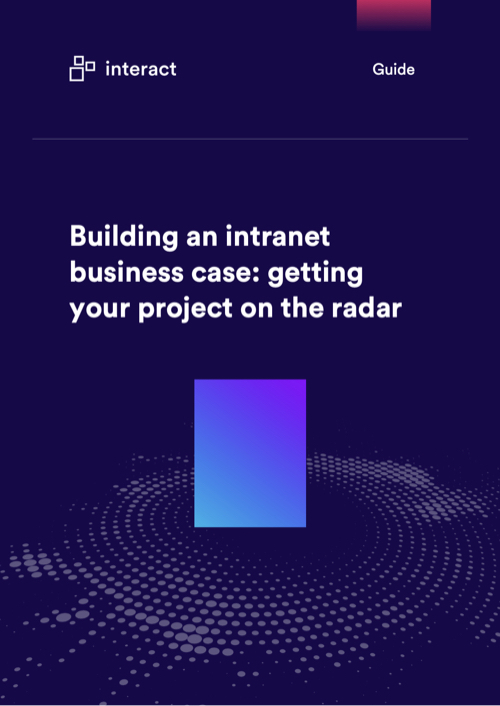Dictionaries and language apps may have picked “vaxxed,” “variant,” and “languishing” as their buzzwords of 2021, but for us it was “employee experience.”
After years of discussing employee engagement, advocacy, and satisfaction, why did employee experience suddenly become the phrase on everybody’s lips?
Obviously, the main catalyst was Covid. The pandemic accelerated remote working by a handful of years. This was positive for some because it meant that many organizations were able to keep the lights on, but it was often also at the cost of employees who suffered record levels of stress and burnout. One 2021 American Psychological Association survey revealed that more than two in five employees intended to change jobs this year, up from one in three in 2019.
This led to what’s been called the Great Resignation, but also more broadly to a sense of disconnection we now know as the Great Discontent.
Employers want to improve the employee experience

Many employers understand that to combat this feeling of employee dissatisfaction they need to create better employee experiences at every stage. From recruitment through to exit interviews, workflows and platforms should be optimized to create a frictionless experience where users are supported to be productive, connected, and informed.
Building an intranet business case
Employee experience software is seen as a driver in this shift because whole-organization platforms like intranets create a virtual-home experience. Through their company intranet employees can access business apps, resources, and communications. Just as importantly though, they can connect with colleagues, leaders, and the organization as a whole. By fostering this sense of connection, employee experiences can be improved.
Research from Willis Towers Watson suggests that more than 90% of employers intend to make employee experience a main priority in 2022. They will be searching for more ways to do this across the organization, presenting an opportunity for the application of new workplace technologies that enhance communications and connection.
If you work in internal communications, HR, or any other department that already understands the need for an employee experience platform, now could be the time to make a business case for you to get the best intranet for you in 2022.
Here are 8 tips to make your intranet business case better.
#1 Understand which benefits leaders want to hear
Uniting all employees to achieve common goals and deliver business growth is the top-line objective for any member of the C-suite.
Correlating those company-wide or strategic performance indicators with an internal communications tool can seem far-fetched. However, an intranet serves as a powerful employee experience platform: impacting how staff connect to who you are, what you do, and your long-term vision.
Building an intranet business case
That sense of purpose and understanding then feeds into how and why your employees choose to work for your organization. Engaged and invested employees deliver on those all-important KPIs: making your organization more efficient, productive, and profitable. Among the business case benefits an intranet can bring are:
- Aligning staff behind your business mission, values, and brand by bringing them front-and-center, recognizing desired behaviors, and creating values-based recognition programs
- Connecting staff to news, events, updates, leadership: improving visibility, trust, and alignment
- Increasing productivity with quicker access to tools, information, and expertise, gaining associated time, cost, and resource savings
#2 Don’t forget how employee experience software works for HR
Our employees are our most valuable assets: those charged with delivering on our brand promise, realizing our organizational objectives, delivering an exceptional experience for customers and consumers, and much, much more. In today’s economy, they can be a crucial differentiator when it comes to defining our business success.
Designing employee journeys that will help them reach their full potential and perform their roles to the best of their abilities is a growing challenge, particularly as today’s workforce is the most diverse in terms of age, experience, and skill set. With the additional challenge posed by managing those experiences at a distance for our remote workers, there’s a growing demand for supporting technology that will ensure all employees – regardless of their location, role, demographic, or needs – can benefit from a successful, inclusive, and engaged culture.
An intranet is more than a communications tool: it is, arguably, the sole digital workplace platform purpose-designed to shape the employee experience. Supporting everything from well-being to communicating your employer brand, it will offer returns on key HR objectives, including workplace satisfaction, retention, engagement, and more.
Building an intranet business case
Here’s how an intranet can help:
- Build, communicate, and embed company culture, including creating a centralized virtual culture for remote or dispersed staff
- Drive employee engagement with corresponding gains for productivity, employee advocacy, retention, and discretional effort
- Employer brand, recruitment, and retention benefits by shaping a positive employee experience at every stage of their lifecycle within the organization
#3 Get prepped
Before you begin creating a business case, ask simple questions to guide its production:
- Who is the audience?
- Who are the key decision makers?
- What format should your business take – as a document, presentation, or both?
- Is there an existing template or do you need to begin from scratch?
- Are there compliance or regulatory requirements to be addressed?
- When is the best time to submit your plan?
With these questions in mind you can make early decisions that will mean the end result has a more likely chance of success.
#4 Identify key stakeholders
Determining the audience for your business case and the decision makers who ultimately hold responsibility for sign-off, approval, or roll-out of your project is essential. Bear in mind that these two groups aren’t necessarily mutually exclusive: depending on your specific organization, you may be called on to present your business case to one group, who will then escalate it to the next level. Different stakeholders will hold varying degrees of interest and power.
The best way to identify these and determine the level of investment required for each group is a simple stakeholder map, like the one below.

Once you have determined those who are the highest priority for you to manage and satisfy as part of your business case process, you can dig a little deeper into the priorities of each group. What are they most concerned about? What is important to their department or individual role? What are their business priorities or objectives?
#5 Define the project’s objectives
To demonstrate that a new intranet platform can answer some unmet challenge within your organization, you need to explore the objectives your intranet will support your business to achieve. These typically fall into one of two categories: generic and specific.
Generic objectives are typically high-level and may be difficult to quantify. They won’t necessarily be defined in business strategy, but for an intranet project, they represent considerable potential and should be explored in full.
What are the current challenges or pain points being faced by your business departments and their employees? What generic objectives have already been set by those departments that an intranet could help address?
Remember to define your objectives by stakeholder or department.
Building an intranet business case
Specific objectives are more precise and often quantifiable by numbers, timeframe, or function. For your employee experience platform business case, you should look to the main stakeholders in the project and their pain points.
A good way to do this is to assign a value to your potential improvement: for example, “Reduced email traffic” may become “Reduce internal email traffic by 40% through the introduction of intranet social tools, reducing burden and cost overhead of internal servers.”
Again, these objectives for improving the employee experience can be considered in relation to stakeholders, departments, or decision makers. How do HR want to improve the employee experience and what can software do to support that?
#6 Research employee experience software options
Doing due diligence for a company software purchase obviously means a little more work than reading a few Yelp reviews. Creating a solid intranet business case also means demonstrating to decision makers that you have assessed your organization’s needs against what is currently available in the market.
Although you may already have a preferred option in mind, you should include a section outlining the options you considered. For an intranet project, the options we typically see evaluated include: doing nothing; Microsoft SharePoint; building an intranet ‘inhouse’ where resource is available; or selecting a specialist vendor who specializes in employee experience software.
Of these options, the last one has the most substantial set of research options:
Google will be able to help you identify vendors offering some of the features and services you may need, but you can also utilize third-party resources to strengthen your research. These may include analyst reports, such as:
- MWD Advisors
- Constellation Research
- Clearbox
- Gartner
- Forrester
If you want to read reviews from active users then both G2 and Capterra can also be useful sources.
#7 Be honest about the risks
Setting out risk can seem counterintuitive when attempting to persuade or influence your decision makers to invest in an intranet project. If you’re looking to convince them this is going to be hugely beneficial for the business, why would you set out all the ways it could go wrong?
Although being aware of what could negatively impact your organization is important, the real value of presenting risk in your business case is to demonstrate how these can be identified and mitigated, to minimize potential financial damage.
This form of contingency planning is known as “what if?” analysis. Essentially, you need to use this section to show you’ve thought through risks, that you know how to plan for them should they arise, and that your plan can survive when things go wrong.
Building an intranet business case
When delivering an intranet project, there are two distinct types of risk:
- Implementation risk – The risk that a proposed investment may deviate from the original or expected requirements, resulting in higher costs than anticipated
- Outcome risk – Refers to the risk that the business or technology needs of the organization may not be met by the investment, resulting in lower overall total benefits
One of the simplest ways to present risk is with an impact vs. probability graph. This sets out potential risks and evaluates how likely they are to occur, and the level of impact they present to the business.

#8 Present a persuasive case
Creating a compelling case to get the employee experience software you’ll need in 2022 doesn’t end with completing the document itself.
Wrapping up and finalizing the presentation of your intranet business case will be dependent on:
- Whether the business case is to be read and reviewed as a document, or delivered as a presentation (or both)
- Who will be reading it/reviewing it
- Who will be presenting it (if applicable)
Different decision makers and stakeholders will have a diverse range of communication styles, which can be a challenge. For this reason, it’s best to prepare for all eventualities and preferences where possible.
Unless you’re adhering to a strict, predetermined template, it’s worthwhile creating these three items:
- One-page executive summary
- Longform business case document, with full details and appendixes (if required)
- Presentation
These enable you to cater for the pragmatist, who seeks only top-level information and figures, through to the analyst, who will want to review more in-depth research.
Get the best intranet for your needs
There’s no denying that 2022 could be just as challenging as 2020 and 2021. For organizations to weather the storms of unpredictability they’re going to need to support their people to be healthy, productive, and engaged.
While employee experience became a new way of thinking about staff-organization interaction this year, the principles for improving that relationship are much older. If you can create great (digital) workplaces that people want to be part of then they will stay with you for longer and perform better. Great internal communications are a big part of that because better employee experience also depends on being informed and connected. Whether you call it intranet software or an employee experience platform, the tools you need are available and can help to establish that culture of communication.
Good luck choosing the right technology for your organization and putting together a case capable of getting signed off.


